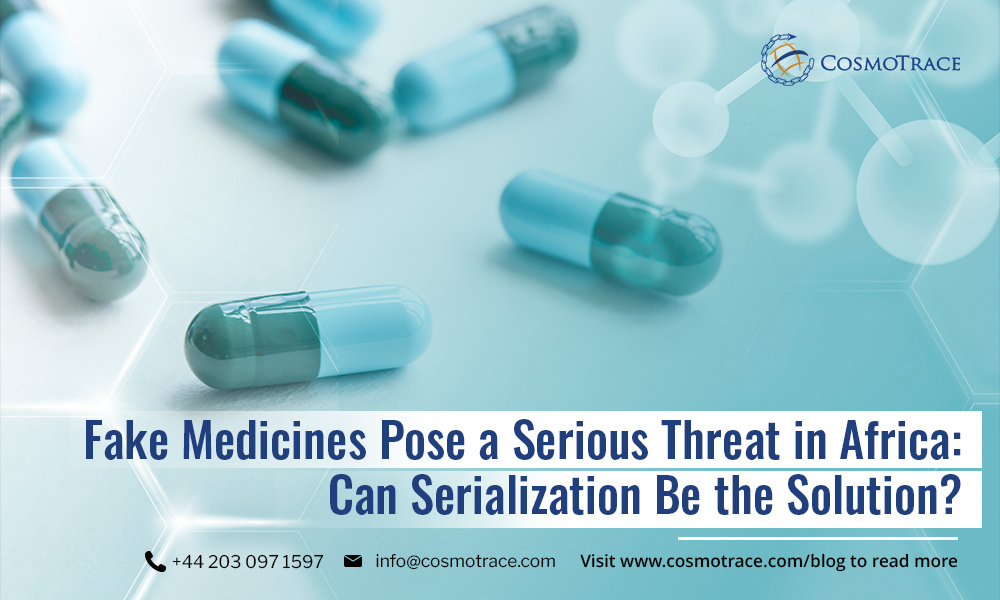Another crucial challenge to be addressed is the increased circulation of fake and counterfeit medicines. Counterfeit or fake medicines are medicines which are deliberately and fraudulently mislabelled with respect to identity and/or source. A WHO report stated that Africa alone accounts for 42% of globally detected cases of counterfeit and substandard medical products. Coupled with poor regulation policies and widespread corruption, fake drugs abound in markets, the harm from which people suffer and die in dreadful numbers. The borders of the region are very porous leading to smuggling of fake, substandard, counterfeit and falsified medicines. The increase in circulation of fake and counterfeit medicines in Africa has posed a great challenge in accessing quality medicines and this has caused waste of funds by consumers, and loss of revenue to pharmaceutical companies up to 40%. To circumvent this challenge, more deliberate effort and attention need to be put in curtailing the silent and devastating effects of fake and counterfeit medicines circulating in Africa.
The proliferation of counterfeit medicines in Africa is a grave concern, posing significant health risks to millions of people. Counterfeit drugs can be ineffective at best and lethal at worst, contributing to treatment failures, increased mortality rates, and the spread of drug-resistant diseases. As governments and health organizations grapple with this pervasive issue, serialization emerges as a promising solution to combat the menace of fake medicines. But what exactly is serialization, and how can it help in mitigating this critical problem?
The Menace of Fake Medicines in Africa
Counterfeit medicines are a pervasive problem in many African countries. According to the World Health Organization (WHO), a substantial percentage of medicines in some regions are counterfeit. Counterfeit or fake medicines are medicines which are deliberately and fraudulently mislabelled with respect to identity and/or source. A WHO report stated that Africa alone accounts for 42% of globally detected cases of counterfeit and substandard medical products.
The increase in circulation of fake and counterfeit medicines in Africa has posed a great challenge in accessing quality medicines and this has caused waste of funds by consumers, and loss of revenue to pharmaceutical companies up to 40%. These fake drugs often contain incorrect or harmful ingredients, lack the necessary active components, or are sold in deceptive packaging designed to mimic legitimate products.
The consequences of consuming these counterfeit medicines can be dire:
- Ineffective Treatment: Patients do not receive the intended therapeutic benefits, leading to prolonged illness or death.
- Health Risks: Counterfeit drugs can cause severe adverse reactions or toxic effects.
- Drug Resistance: Incomplete treatment with substandard drugs can contribute to the development of drug-resistant strains of diseases, complicating future treatment efforts.
Understanding Serialization
Serialization is the process of assigning a unique identifier to each product unit, enabling the tracking and tracing of pharmaceuticals throughout the supply chain. This identifier, often in the form of a barcode or QR code, allows each unit to be monitored from the point of manufacture to the point of sale.
Serialization involves several key components:
- Unique Identifier: A distinct code for each product unit.
- Data Management: Systems to capture, store, and manage serialization data.
- Verification and Authentication: Mechanisms to verify the authenticity of products at various points in the supply chain.
Serialization offers several advantages that can significantly reduce the prevalence of counterfeit medicines in Africa:
Enhanced Traceability: Serialization allows for the precise tracking of each product unit through the supply chain. This traceability makes it easier to identify and intercept counterfeit products before they reach consumers. In the event of a counterfeit detection, authorities can trace the product back to its source and take corrective actions.
Verification and Authentication: Consumers, healthcare providers, and regulators can verify the authenticity of a product using its unique identifier. Mobile apps and online platforms can provide instant verification, empowering consumers to check the legitimacy of their medicines before use.
Supply Chain Integrity: Serialization helps secure the pharmaceutical supply chain by making it more transparent. Each transaction and movement of the product can be recorded and monitored, reducing the opportunities for counterfeiters to introduce fake products into the supply chain.
Regulatory Compliance: Many countries are implementing stringent regulations requiring pharmaceutical serialization. By adopting serialization, pharmaceutical companies can ensure compliance with these regulations, avoiding legal penalties and fostering trust with regulators and consumers.
Data Analytics and Monitoring: Serialization generates a wealth of data that can be analyzed to detect patterns and anomalies indicating counterfeit activity. Advanced data analytics can help identify and address vulnerabilities in the supply chain, further strengthening the fight against counterfeit drugs.
Conclusion:
The threat posed by counterfeit medicines in Africa is a critical public health issue that demands immediate and effective action. Serialization presents a promising solution to this problem by enhancing traceability, ensuring product authenticity, and securing the pharmaceutical supply chain. By overcoming the challenges and leveraging the benefits of serialization, African countries can make significant strides in protecting their populations from the dangers of fake medicines. As governments, health organizations, and pharmaceutical companies collaborate to implement serialization, the vision of a counterfeit-free pharmaceutical market in Africa becomes increasingly attainable.
References:
- World Health Organization. Counterfeit Drugs. 1992. Available from: http://www.apps.who.int/iris/bitstream/10665/58358/1/WHO_DMP_CFD_92.pdf. Accessed: 20 February 2022.
- WHO (2017) 1 in 10 medical products in developing countries is substandard or falsified. Geneva, Switzerland. https://www.who.int/news/item/28-11-2017-1-in-10-medical-products-in-developing-countries-is-substandard-or-falsified. Accessed: 20 February 2022.
- Seiter A. Health and economic consequences of counterfeit drugs. Clin Pharmacol Ther. 2009; 85(6): 576-578.
Please write to us at info@cosmotrace.com for more details


